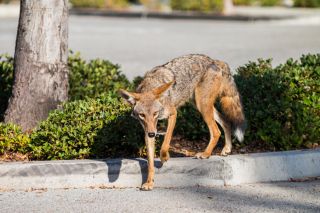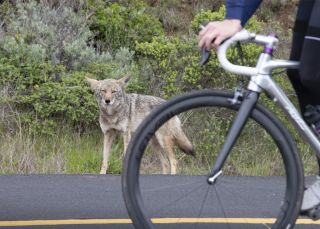Animal Behavior
City Life Adds to the Stresses of Urban Coyotes
Urban living may be stressful, but coyotes prove resilient.
Posted August 29, 2023 Reviewed by Abigail Fagan
Key points
- Researchers analyzed cortisol levels in hair samples from coyotes living in the Chicago Metropolitan area.
- Coyotes living in more developed areas had higher cortisol levels, indicating they experienced more stress.
- Stress levels were also impacted by body condition and social status and showed individual variability.
.jpg?itok=balkqqwx)
As urban areas encroach more and more into formerly natural spaces, some wild animals are making a go of it in human cities. Even relatively large carnivores, such as coyotes, have become common in many metropolitan areas. City living can offer access to resources like food and shelter, but it comes with its own unique challenges—enough to elevate stress levels among urban coyotes, according to a new study.
The study is the latest to come out of The Urban Coyote Research Project, which has monitored coyotes living in the Chicago Metropolitan Area since 2000. Stanley Gehrt, a wildlife ecologist at The Ohio State University and leader of the project, says it started with capturing coyotes and outfitting them with radio collars to track their movements. He and his colleagues initially assumed that the population would be small and clustered around large, green spaces in the city, but the data soon proved them wrong. The population grew as coyotes took advantage of all parts of the urban landscape, even moving into the core of the city.
“We had certain expectations in terms of what we thought coyotes could do, and they continually show that we underestimated them,” says Gehrt.
Measuring Stress
For the new study, the researchers captured nearly 100 coyotes, shaving a small patch of hair from their rumps before outfitting them with radio collars and sending them on their way. The team analyzed the hair samples for the concentration of cortisol, a hormone produced in association with stress. Hairs store cortisol over time, and thus provide an estimate of long-term stress over the previous weeks or months. The radio collars provided information on the coyotes’ movements.

The results, Gehrt says, were complicated. They found that coyotes living in the most highly developed areas had higher cortisol levels than animals living in suburban or natural areas, suggesting they experience chronic stress. However, urbanization was not the only factor influencing stress levels.
The researchers found that poor physical condition (for instance, infection with mange) was linked to higher stress levels across different landscapes. So was social status: Alphas, the dominant pair that are responsible for running the pack, experienced more stress than coyotes beneath them in the social hierarchy, and transients (adult coyotes that have left their parents and are without a pack yet) also had high stress levels.
City Coyotes
In addition to these factors, the study revealed plenty of individual variations in stress levels, even among animals in the highest-stress groups. It seems that some coyotes may be better able to cope with the novel environments and risks associated with cities than others.

“Though there was a trend for higher levels of stress among more urban coyotes, there are exceptions,” says Gehrt. “Some coyotes are adjusting to the urban lifestyle and finding ways to exploit these heavily developed areas without experiencing a lot of stress.”
Gehrt says that other research from the Urban Coyote Research Project indicates that, overall, coyotes are handling the potential stress of urban living pretty well. The coyotes living in downtown Chicago have the same survival and reproduction rates as the ones living in the greener outskirts of the city.
“This is one of the first studies of stress in a medium to large mammalian carnivore living in an urban area,” says Gehrt. “The results help fill in some knowledge gaps in terms of how wildlife live in cities—and they show that coyotes are remarkably resilient and adaptable.”
References
Robertson KE, Ellington EH, Tonra CM, Gehrt SD. Stress in the city? Coyote hair cortisol varies with intrinsic and extrinsic factors within a heavily urbanized landscape. Sci Total Environ. 2023 Aug 3;901:165965. doi: 10.1016/j.scitotenv.2023.165965.


